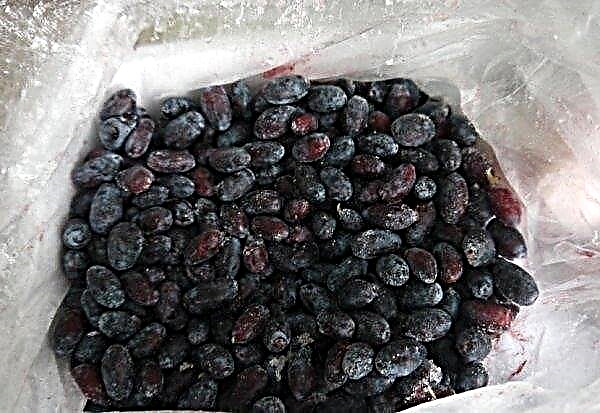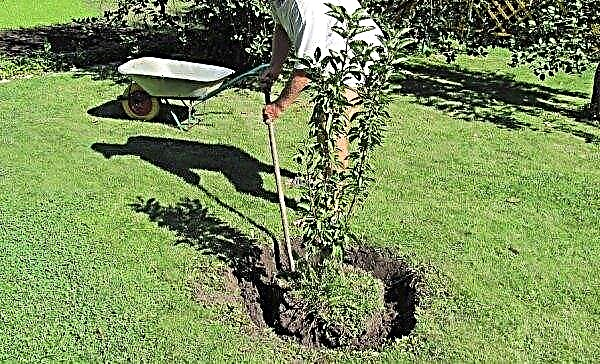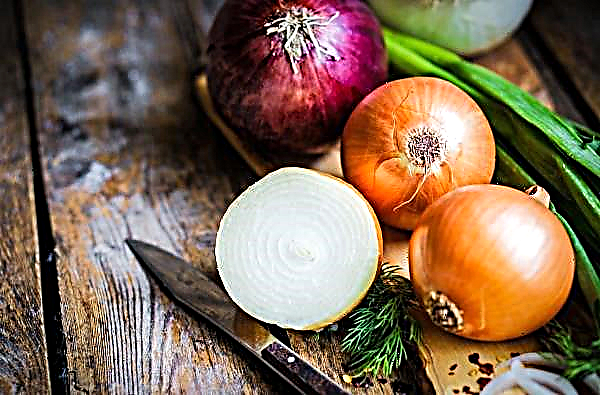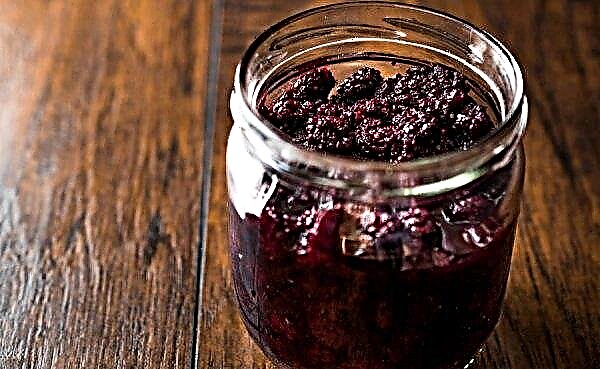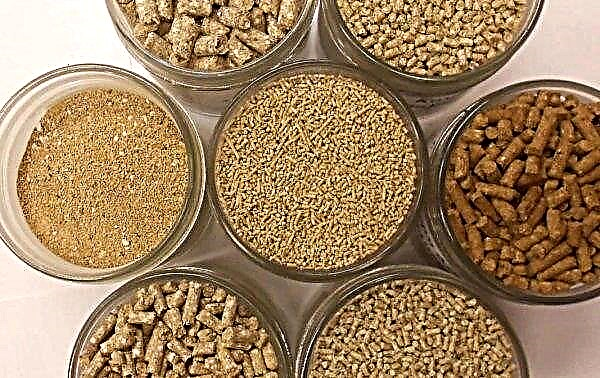This article will discuss one of the best and most common breeds of chickens - cross-broken brown. Below you can find information about its benefits, as well as conditions and proper nutrition of chickens and adult chickens.
History reference
Broken brown chickens were bred by German breeders, namely the company Lohmann Tierzucht GmbH. As a result of crossing 4 cross hybrids, hens of meat and egg direction appeared. The founders of this breed are Rhode Island and Plymouthrock.
Representatives of broken brown outperform their predecessors in all directions. The date of the final formation of the breed is 1970.
Description and distinctive features of the breed
This breed has several different representatives, which vary in color (brown or white). In terms of productivity, they are almost no different. However, brown is considered to be the best, which is less demanding on the content.
Appearance
| Head | small |
| Crest | scarlet color, leaf shape |
| Beak | short and narrow, yellow-gray; red spot around the beak |
| Neck | strong and low |
| Chest | wide |
| Stomach | tight and wide |
| Wings | well developed, tightly pressed to the body |
| Tail | relatively small |
| Paws | strong yellow-gray |
| Plumage and color | roosters are red-brown, and the hens are slightly lighter; there are blotches of white; there is a white subspecies; dense plumage, a lot of fluff |
Character
Birds are very active and mobile, so they are almost not obese. They practically do not respond to stressful situations, so stress does not affect their productivity. And chickens and roosters are calm in nature, which allows them to get along with other birds.
Important! The body of a layer indicates its age. A young chicken looks slim, and a saggy stomach and wide hips are characteristic of an old bird.
Conflicts are possible only when the birds do not have enough space.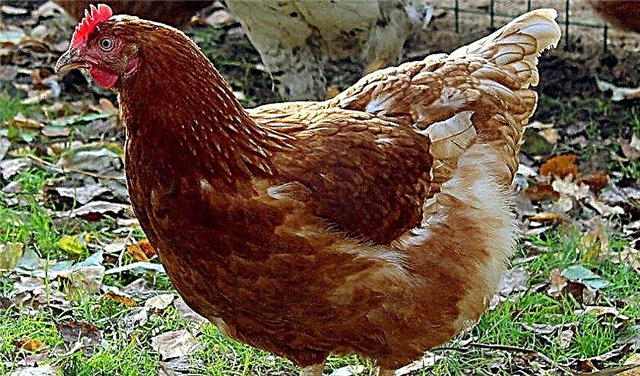
Advantages and disadvantages
- Among the advantages of the breed are the following:
- early maturation and oviposition (5-6 months);
- high egg production;
- almost 100% survival of young animals;
- large eggs;
- unpretentiousness in leaving;
- good acclimatization;
- tasty meat.
- But birds have some disadvantages:
- decrease in egg production after 80 weeks;
- productive qualities are transmitted only by selection. During reproduction, only some “pluses” are naturally preserved. Therefore, a constant purchase of young animals from incubators is needed.
Content Rules
Broken Browns are unpretentious in content. But in order for the return to be 100%, some rules must be observed.
Bird house
The chicken coop must meet the following requirements:
- enough space is needed (no more than 4–5 chickens per 1 m²), otherwise the tightness will affect their productivity;
- the temperature should be within +15 ... + 18 ° С, and humidity - 60–70%. To prevent birds from freezing in winter, the house should be insulated. The presence of drafts is unacceptable;
- the floor can be covered with a bed of straw or sawdust, but care must be taken to keep it dry and loose. The same litter is also suitable for nests;
- for egg production to be high, the daylight should be at least 16 hours. In winter, you need to use lamps for illumination;
- nests and perches are needed in the chicken coop. Poles (with a diameter of about 40 mm) for perches are placed at a height of about 80 cm, and nests - 60 cm. Nests are needed spacious, their number is not less than 1 in 4 hens.

Care
Broken Browns need standard care.
Recall the main points:
- daily airing;
- it is difficult to call chickens clean; therefore, regular cleaning is necessary;
- sanitize twice a year. For this purpose, formalin is used (but it is unsafe), bleach or iodine granules;
- the litter changes with pollution, but at least once every 2 months, and you also need to monitor its dryness;
- To combat skin parasites, chickens “bathe” in dust or sand. Any wide tank filled with ash mixed with earth or sand is suitable as an ash bath. They are better to install on walking platforms.
Did you know? Hens do not rush in the dark, they will wait for the morning or the inclusion of artificial lighting. And in order to accustom them to rush in one place, an egg or its fake is placed in the nest.
Walking patio
Hens are mobile creatures, so they need a place for walking. This is necessary so that the chickens do not get fat, and this does not reduce productivity. In the summer, birds can find additional food in the form of insects, worms and greenery.
There are some requirements for the courtyard:
- the size of the walk should not be less than ½ of the house;
- it is better if on the sides and from above it will be fenced with a grid. Height - 1.5–1.7 m;
- for free exit of the bird from the chicken coop to the paddock, you need to make a hole with a size of 40 × 40 cm;
- it is advisable to install drinkers and trays with food under shelter;
- an ash bath is needed;
- well, if there is a corner for grazing in the courtyard with grass. If this is difficult, then V-shaped trellis feeders for greens can be hung up.

Feeding troughs and drinking bowls
If the bird is most of the time on the walk, then there need to place feeders and drinking bowls. They are placed indoors if the chickens have a limited range (for example, in winter).
Feeders need to pay special attention to:
- its size should be such that 1 chicken has at least 7 cm;
- approximate dimensions for 20 chickens - 110 × 25 × 12 cm;
- the design should prevent the spread of food, you can cover the top with a grid with large cells (for free access to food);
- metal containers are suitable for wet foods, and wooden containers for dry ones;
- the top of the feeder should be at the back of the chicken;
- for chalk, shells and sand, flat containers are used.
Poultry farms use special drinkers. At home, you can use any containers. A good option is a metal drinker in the form of a gutter and with fittings on the sides (under running water).
Moult and egg laying break
Shedding chickens are tolerated normally, but egg production for 1–2 months ceases. This mainly happens between October and December. At this time, the appetite worsens in the birds and they lose weight. To molt ended faster, it is necessary to introduce vitamin and mineral supplements, as well as fish oil, into the diet.
When the hens shed, egg production spontaneously recovers.
Herd replacement planned
As mentioned earlier, one of the disadvantages of this breed is a decrease in productivity after 20 months. At poultry farms, hens are fed with premixes, which causes maximum egg production, but also the rapid wear of the birds (1 year). At home, chickens are kept longer.
After a year and a half, it is desirable to replace the herd, since in the future the number of eggs in chickens decreases and the taste of meat is lost. The old bird is slaughtered and young laying hens are acquired.
A new herd is settled in a well-cleaned and sanitized chicken coop. Walls are treated with lime and other disinfectants.
Important! If replacement of chickens is planned through chickens, then they must be purchased 4 months before the slaughter of the old layers, so that there is no interruption in the receipt of eggs and time is left to prepare the premises.
Feeding ration
To maintain high productivity for chickens, not only the conditions of detention are important, but also a proper and balanced diet.
Chickens
The first days of the chicks are fed:
- small cereals;
- boiled eggs;
- cottage cheese and chopped greens are gradually introduced.
On day 9-10, the chickens begin to give:
- starter feed;
- vitamin and mineral supplements.
Gradually, the starting compound feed is replaced by the usual one, and the following are also introduced into the diet:
- corn flour;
- roots;
- greenery.
Did you know? In a broken brown, the sex of a chicken is determined by the color of the fluff: yellow is a rooster, and dark-red is a chicken.
Young animals are only watered with warm water (+38 ... + 41 ° С). It is useful to give a decoction of chamomile or a weak solution of potassium permanganate. In the early days of chickens you need to drink “Baytrilom”.
Adult chickens
Most poultry farmers prefer to feed the laying hens with factory mixtures. For adult chickens, growth and finish compound feeds are used, which together with mashrooms and sprouted wheat should make up the bulk of the nutrition. Grains give only crushed, because whole is digested and assimilated for a long time (up to 6 hours).
The best grain crop is considered to be corn, barley is useful, sometimes you can give millet.
In addition to the main diet, you need to give:
- greens in summer, and shredded hay or grass granules in winter;
- chopped vegetables (carrots, beets, boiled potatoes) can be added to the mixers;
- dairy products (cottage cheese and whey);
- eggshell, chalk or shells, as well as bone meal;
- cabbage and beet leaves, legumes;
- fish waste or fishmeal;
- pumpkin seeds and yeast.
Basically, the chicken diet consists of 3 feedings:
- 1-2 hours after awakening, grain mixtures or mixed feeds are given;
- about 15 hours, the bird is fed with wet mashrooms and compositions of vegetables, herbs, etc .;
- evening feeding consists mainly of cereals or animal feed.
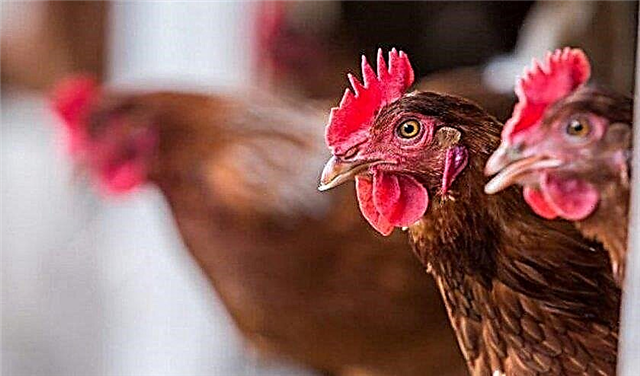 It is better if the same intervals are maintained between feedings. It is very important that chickens have plenty of clean water.
It is better if the same intervals are maintained between feedings. It is very important that chickens have plenty of clean water.From how the owner takes care of their pets, their return will depend. Therefore, you need to create the most comfortable living conditions and varied nutrition. And despite some shortcomings, broken browns will fully recoup the costs of their provision by supplying the owner with plenty of eggs and tasty meat.



